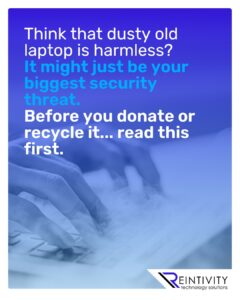
Trust is everything – particularly in Insurance services.
Clients hand over deeply personal data—medical histories, financial records, Social Security numbers—expecting it to be safeguarded with the utmost care. But what happens when that sensitive data is sitting on an old laptop gathering dust under your desk?
Worse: what happens if you recycle or donate that device, thinking it’s clean… but it’s not?
Let’s break it down—because secure device disposal isn’t just an IT issue. It’s a business-critical step for staying compliant, maintaining trust, and protecting your bottom line.
Why “Deleted” Doesn’t Mean Gone
It’s easy to assume a factory reset or file deletion makes your device safe to toss. Unfortunately, that’s far from true.
Most “deleted” data can still be recovered—especially by someone who knows what they’re doing. Think emails, client files, policy applications, even login credentials to your core systems.
For insurers, that means potential exposure of:
- Customer PII
- Claim data
- Underwriting notes
- Regulatory compliance documents
- Internal communications
One compromised device could trigger a data breach with legal, financial, and reputational fallout. HIPAA, GLBA, and state-level privacy laws don’t take kindly to carelessness—even if it comes from an old, forgotten laptop.
5-Minute Reality Check: Could This Be You?
- Do you have old PCs, phones, or tablets stored in the office “tech graveyard”?
- Has anyone on your team recycled or donated a device without IT review?
- Do you rely solely on factory resets or basic deletion tools before disposal?
- Are your current disposal processes undocumented or ad hoc?
If you checked yes to any of these, don’t panic—but don’t wait either.
The Good News: You Can Fix This (Easily)
Here’s your quick-start guide to protecting sensitive data before saying goodbye to old devices:
Step 1: Back It Up (Before You Break It Down)
Before wiping or destroying anything, make sure you’ve saved anything important.
- Where? Cloud storage or an external drive.
- What to back up? Emails, contracts, claim history, client communications—anything you’d regret losing.
This step ensures you’re protecting both your clients’ data and your own workflows.
Step 2: Use Pro-Grade Data-Wiping Tools
A proper wipe doesn’t just “delete”—it overwrites your data multiple times, making it unrecoverable.
Free tools like DBAN (for PCs) or Apple’s Disk Utility (for Macs) are good, but professional-grade software is even better. For mobile devices, look for mobile management tools with secure wipe features.
Not tech-savvy? That’s where a trusted IT support partner (like us) comes in. We do it right—and we document it for your records.
Step 3: Physically Destroy the Drive (Optional but Effective)
If you’re especially cautious—or if the device is headed to recycling—consider physically removing and destroying the hard drive or SSD.
- Tip: A few hits with a drill or hammer (wearing protective gear) will do the job.
- Why? Even wiped drives can sometimes retain residual data. This step ensures nothing gets out.
Step 4: Choose a Certified Recycler
Not all recycling is created equal. Look for recyclers that are:
- R2 or e-Stewards certified
- Willing to provide chain-of-custody documentation
- Familiar with insurance and healthcare compliance needs
This isn’t just eco-friendly—it’s risk-reduction at its finest.
Step 5: Don’t Forget Phones and Tablets
Your team’s smartphones and tablets are full of:
- Voicemails from clients
- Insurance apps with saved login info
- Two-factor authentication links
- Texts and emails that reveal account details
Before donating or recycling mobile devices, follow the same process:
Back up > Wipe securely > Confirm it’s clean.
Bonus: Devices You’re Probably Forgetting
While laptops and phones are the obvious culprits, don’t overlook:
- External hard drives and USBs
- Copiers and printers with built-in storage
- Surveillance or IoT devices
- Retired workstations and monitors with embedded hardware
If it ever held data, it deserves a proper goodbye.
The Fallout of a Forgotten File
Let’s say someone recovers client data from a poorly wiped device you donated to a school fundraiser. That data leaks online. Suddenly you’re facing:
- Client mistrust (and possible churn)
- Regulatory fines or lawsuits
- Embarrassment across the community
- Increased insurance premiums or denial of cyber coverage
All because of a 10-minute task that wasn’t done right.
Need Help? Let the Pros Handle It
Your focus should be on serving policyholders—not decoding disk-wiping tools or shredding hard drives.
We’re a Chicago-based managed services provider specializing in helping small and midsized insurance firms stay secure, compliant, and productive. Whether you’re clearing out five devices or fifty, we can:
- Wipe or destroy old tech securely
- Document the disposal process
- Help build a future-ready tech disposal policy
In Summary: Retire Devices the Right Way
| What To Do | Why It Matters |
|---|---|
| Back up important files | Prevent data loss |
| Wipe with pro tools | Make data unrecoverable |
| Destroy the drive (if needed) | Eliminate lingering risks |
| Use certified recyclers | Ensure compliance |
| Call your IT partner | Save time and stress |
Ready to Clean Out the Tech Graveyard—Safely?
We’ll help you say goodbye to old devices without saying goodbye to your security.

